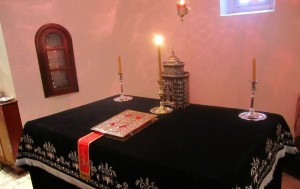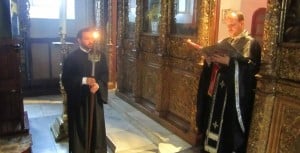The Twelve Gospels (Vassilios Papavassiliou)
28 Απριλίου 2016
[Previous Publication: http://pemptousia.com/2016/04/the-mystical-supper/]
 I am probably in serious trouble for saying that, so allow me to quickly move on before I really put my foot in it. Let us now turn our attention to the service of Great Friday that takes place on Thursday evening. At this service, we have the reading of the Twelve Gospels, which tell us the accounts of Christ’s trial, suffering and death. The fifth gospel sees Christ sentenced to death by crucifixion, and so, after this Gospel Reading, the priest takes the crucifix that stands before the altar, and, preceded by lights, he carries it around the church in procession and places it in the centre. Bear in mind what I said earlier: how the church expresses her wonder at God’s humility; the Creator doing things for us which are, quite frankly, degrading. Nowhere is this more emphatic than in the hymns of Great Friday. I have selected two hymns from Great Friday, and the first is the hymn that is chanted during and immediately following the procession of the crucifix:
I am probably in serious trouble for saying that, so allow me to quickly move on before I really put my foot in it. Let us now turn our attention to the service of Great Friday that takes place on Thursday evening. At this service, we have the reading of the Twelve Gospels, which tell us the accounts of Christ’s trial, suffering and death. The fifth gospel sees Christ sentenced to death by crucifixion, and so, after this Gospel Reading, the priest takes the crucifix that stands before the altar, and, preceded by lights, he carries it around the church in procession and places it in the centre. Bear in mind what I said earlier: how the church expresses her wonder at God’s humility; the Creator doing things for us which are, quite frankly, degrading. Nowhere is this more emphatic than in the hymns of Great Friday. I have selected two hymns from Great Friday, and the first is the hymn that is chanted during and immediately following the procession of the crucifix:
Today, he who hung the earth upon the waters is hung upon a tree.
The King of angels is decked with a crown of thorns.
He who wraps the heavens in clouds is wrapped in the purple of mockery.
He who freed Adam in the Jordan is struck on the face.
The Bridegroom of the Church is affixed to the cross with nails.
The Son of the Virgin is pierced by a spear.
We worship your passion, O Christ.
Show us also your glorious Resurrection.
It is worth nothing here the reference to the Resurrection. The Orthodox Church on Good Friday does not think of Christ’s human pain and suffering in isolation. We marvel at the paradox of God suffering on the Cross – the strange contrast between his humiliation and His eternal glory. The Crucifixion is not about the suffering of a good man; it is about the suffering of God Himself. Behind the image of this broken and humiliated figure, the Church still discerns the Second Person of the Holy Trinity. The Crucifixion, Burial and Resurrection are all seen as one action, and therefore, even in the Crucifixion itself, we already sense victory. The Resurrection is inevitable. This person on the cross is mortal only in His humanity, but in His divinity He is eternal. He is the giver of life, the source of life. Death is contrary to His divine nature. The Crucifixion can end in only one way: Resurrection. It is not wishful thinking. It does not come to us as a surprise. The Church, on Great Friday, awaits the Resurrection with eager expectation.

The second hymn I have selected follows shortly after the Ninth Gospel. This is perhaps the darkest moment of Holy Week. The hymn is chanted slowly in plagal second, which is a dark, almost eerie, tone:
They have stripped me of my garments
And have clothed me in a scarlet robe.
They have set upon my head a crown of thorns
And have given me a reed in my right hand…
Here we have an uncompromising expression of Christ’s humiliation, but come the last line, the focus shifts entirely:
…That I might smash them in pieces, like a potter’s vessel.
Even now, in this utterly humiliated man, the Church still perceives the King of Glory coming to judge the world. I mentioned that because we see the Resurrection as inevitable and consider the Cross, Burial and Resurrection to be one action, we anxiously anticipate the Resurrection even on Great Friday. This is even more true of Great Saturday.
(To be continued)
Source: The Youth Conference & Workshop held at the Greek Orthodox Parish Community Hall of the Holy Cross & the Archangel Michael, Golders Green, London, 14th April 2006





